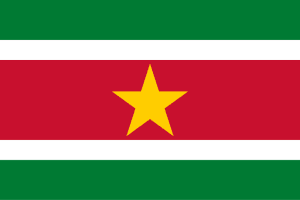
| Colors | HEX Code | RGB | CMYK |
|---|---|---|---|
| Green | #007A33 | 0, 122, 51 | 100, 0, 58, 52 |
| White | #FFFFFF | 255, 255, 255 | 0, 0, 0, 0 |
| Red | #C8102E | 200, 16, 46 | 0, 92, 77, 22 |
| Yellow | #FECC00 | 254, 204, 0 | 0, 20, 100, 0 |
The flag of Suriname has 5 unequal horizontal stripes. The top and the bottom stripes are green, while the central stripe is red bordered by two thin white stripes and a yellow star in the center of the flag on the red stripe. The stripes are unequal, so the green stripes have double width, while the red stripe has quadruple width.
Meaning of the flag of Suriname
The green color in the Flag of Suriname represents hope, in addition to the forests and agricultural lands. The white color is for peace, justice and freedom. The red color symbolizes progress and love of the country. The star is for the unity of the different ethnicities in the country and its yellow color stands for the golden future.
History of the Flag of Suriname
Suriname was a Dutch colony in Latin America. It was given to them by the British to resolve a feud in 1667. Its name was Dutch Guiana. It had its first flag as a Dutch Overseas Territory in 1959. It had 5 multicolored stars that represented the different ethnicities in the country. The flag did not gain much acceptance because it did not represent a united nation. In 1975, Suriname proclaimed independence from the Netherlands, and a competition was held to choose the best design. The flag was officially adopted and hoisted on November 25, 1975, when Suriname became independent.